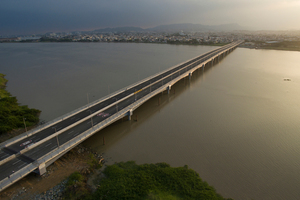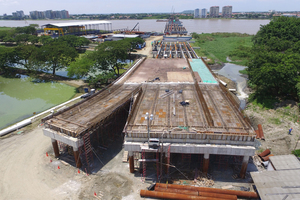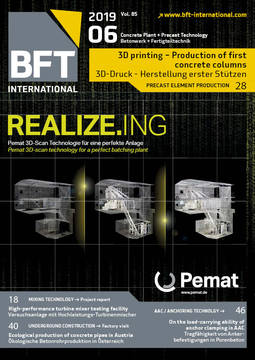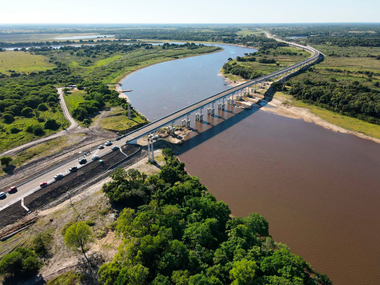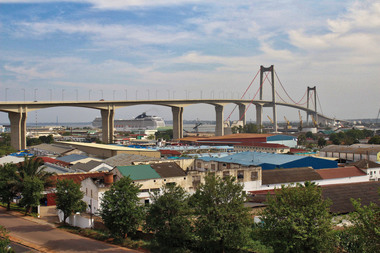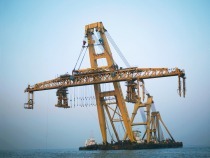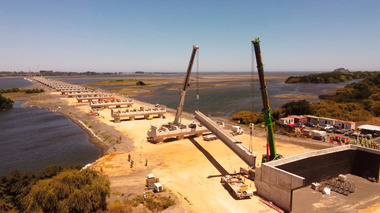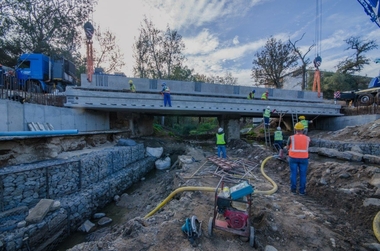The new bridge of Samborondón – Guayaquil in Ecuador
In this new 780-meter-long road structure, 60,000 vehicles will transit daily, alleviating the growing traffic borne by the two provinces of Samborondón and Guayaquil/Ecuador separated by the Daule River. More than one million inhabitants benefit from this infrastructure that has four vehicular lanes, two service lanes, a bike path and a pedestrian lane for each direction. The bridge had an approximate cost of 72 million dollars, and will allow reducing the transfer time in approximately 30 minutes between Guayaquil and Samborondón.
The connection between both with a stretch of approximately 2.25 km in length. The corridor begins in Samborondón, with an access road from Km 3.5 of the main avenue to the bridge, with a length of 780 meters, to end in Guayaquil, crossing over the Narcisa de Jess highway at km 1.3 and ending at Avda. José María Egas and branches connecting to Narcisa de Jess Avenue.
1,200 jobs created
The contractor of the work is the 780 Enlace Consortium formed by the Spanish company Eurofinsa and its local counterpart Compañía Verd S.A.
This complex infrastructure, jointly awarded by the municipalities of both cities, provided for the creation of 1,200 jobs.
The support structure has 39 piles of 800 mm in diameter in the Samborondón viaduct, plus 70 piles of 1,500 mm in diameter that support the diameter in the viaduct of Guayaquil.
The length of the viaduct includes the 410 m that make up the viaduct of Guayaquil plus 780 m of the bridge over the river from shore to shore and the 180 m that make up the Samborondón viaduct.
The main bridge is made up of four lanes plus two service lanes, a bike lane and a pedestrian lane in each direction, while the board has a total width of 26 m.
Prefabricated tiles used in the bridge
The most complicated part of the project was the main bridge over the river. Daule Since it implied once made the piles, the placement of the same under the surface of the river, to sink them to the depth designed by the engineers.
The piling of the piles in the river was a major challenge due to the effect of the tides, the variations of the level of the river arrive to reach the 4 m of difference, which forced an important logistics work. Three large barges were used to maritime logistics, in addition to the tugboats to perform the piling of the piles with cranes and large capacity hammers. This dynamic allowed to comply with the times programmed. In the constructive process for the assembly of beams, strategic decisions were made.
The entire surface of the bridge is composed of prefabricated tiles that were used in the bridge, viaduct and overpass, according to the dimensions and characteristics indicated in the plans and for its manufacture was used a concrete whose resistance to twenty-eight days is 420 kg/cm².
The tendons must have specific characteristics in addition to a high strength, to meet the requirements of prestressed concrete according to ASTM A421 and A416 specifications. The slabs will be located in the width of the overpass, whose layout will be according to the planes whose objective is to absorb the vibrations that originate in the link with the head of the column.
Regulations for structural concrete constructions
In general, the design of the structure must be subject to the regulations for structural concrete constructions ACI 318-95; the calculation memory must be presented in which all the general data used in the design can be observed: The high strength steel used for prestressing cables and the wire is 7 mm will have an Fpµ = 16,000 kg/cm², and the grade 270 strand will have an Fpµ = 18,900 kg/cm². These steels comply with standards 808 of the Manual of MOP-001-1993. Steel wires for pre-stress to be used in concrete, as they are used in applications where cold deformation is required or not for anchoring will be built in high strength steel.
The wires and strands for pre-stressed concrete cables comply with ASTM-A-416 and ASTM-A-421 standards.
Text: Mauro Nogarín

